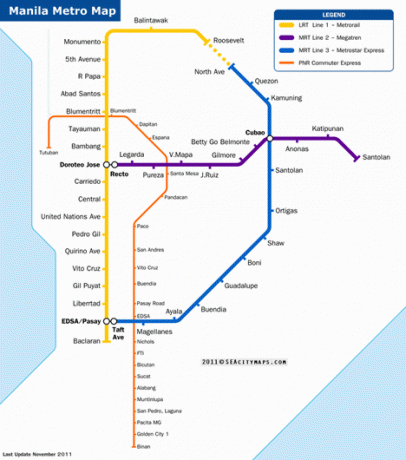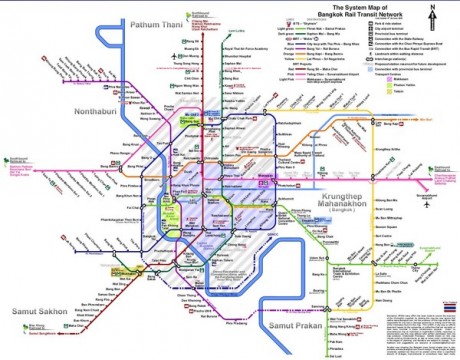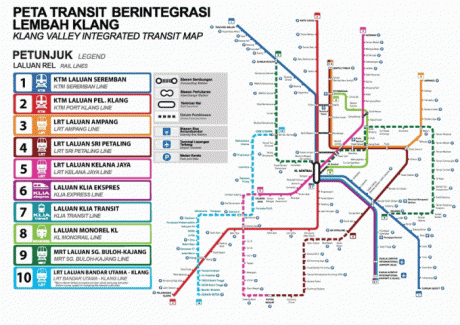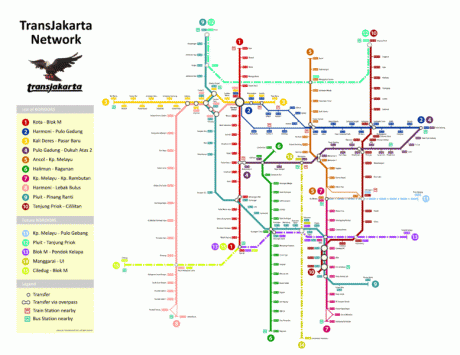It is no longer news that Metro Manila, the Philippines’ premiere urban centre is a mess, and its residents’ biggest bane is its mass transport system. For a metropolis the size of Greater Manila, the existing rail network is extremely sparse and public road transport is utterly chaotic. Over the last couple of years alone, appalling “mishaps” have beset the city’s most “modern” commuter rail lines. Most recent is a head-on collision that occurred on the Light Rail Transit line where, forunately, only one person suffered minor injuries.

Years of neglect have turned Manila’s train services into decrepit national embarrassments. On the busy Metro Rail Transit Line 3 (MRT-3), the number of trains operating has gone from 20 down to just 8 simultaneously running trains resulting in long queues and dangerously-crowded platforms all over the network. MRT management have dismissed the unbearable queues and delays as “normal” even as it attributed the drastic service cuts to “techincal problems such as speedometer malfunction, air-conditioning and poor lighting system.”
Even without these “mishaps”, just looking at the public transport newtwork diagrams of other major southeast Asian cities already gives one a visual idea of just how behind on transport infrastructure development the Philippines is.
| SUPPORT INDEPENDENT SOCIAL COMMENTARY! Subscribe to our Substack community GRP Insider to receive by email our in-depth free weekly newsletter. Subscribe to our Substack newsletter, GRP Insider! Learn more |
Bangkok is currently served by three rapid transit systems: the BTS Skytrain, the underground MRT and the elevated Airport Rail Link. Although proposals for the development of rapid transit in Bangkok had been made since 1975, it was only in 1999 that the BTS finally began operation.

The BTS consists of two lines, Sukhumvit and Silom, with thirty stations along 30.95 kilometres (19.23 mi). The MRT opened for use in July 2004, and currently consists of one line, the Blue Line. It runs for 20 kilometres (12 mi) and has eighteen stations, three of which connect to the BTS system. The Airport Rail Link, more recently opened in August 2010, is operated by the SRT and connects the city centre to Suvarnabhumi Airport to the east. Its eight stations span a distance of 28 kilometres (17 mi).
Rail transport in Malaysia comprises heavy rail (including commuter rail), light rapid transit (LRT), monorail, airport rail link and a funicular railway line. Heavy rail is mostly used for intercity passenger and freight transport as well as some urban public transport, while LRTs are used for intra-city urban public transport and some special uses, such as transporting passengers between airport buildings. There are two commuter rail services linking Kuala Lumpur with the Kuala Lumpur International Airport. The sole monorail line in the country is also used for public transport in Kuala Lumpur, while the only funicular railway line is in Penang.

The railway network covers most of the 11 states in Peninsular Malaysia. In East Malaysia, only the state of Sabah has railways. The network is also connected to the Thai railway 1,000 mm (3 ft 3 3⁄8 in) network in the north. If the Burma Railway is rebuilt, services to Myanmar, India, and China could be initiated.
TransJakarta is a bus rapid transit (BRT) system in Jakarta, Indonesia. It was the first BRT system in Southern and Southeast Asia. The TransJakarta system began operations on January 25, 2004. TransJakarta was designed to provide Jakarta citizens with a fast public transportation system to help reduce rush hour traffic. The buses run in dedicated lanes and ticket prices are subsidized by the regional government. As of 2014, the buses carried more than 350,000 passengers per day with more than 500 buses in operation and more than a hundred in maintenace and for reserve. The subsidy per passenger-ticket in 2011 was around Rp 2,900 ($0.29) and for 2012 the subsidy is expected be around Rp 2,100 ($0.21) per passenger-ticket.

Currently TransJakarta has the world’s longest BRT system (208 km in length), with 12 primary routes and 10 cross-corridor routes. Three more corridors are due to commence construction in 2014 or 2015 and will be partially elevated whereas the existing corridors are at ground level. In addition there are 18 ‘feeder’ routes that continue past the end of the exclusive busways into the municipalities surrounding Jakarta and use special buses that allow for boarding at either ground level or the TransJakarta station platforms.
[NB: Parts of this article were lifted from the Wikipedia.org articles “Bangkok”, “Rail transport in Malaysia”, and “TransJakarta” in a manner compliant to the terms stipulated in the Creative Commons Attribution-ShareAlike 3.0 Unported License that governs usage of content made available in this site.]
- Stupid and stunted: Why Filipinos are looked down upon by the world - December 27, 2025
- This latest Filipino-style ‘anti-corruption’ circus proves that the Philippines needs a serious reboot - November 16, 2025
- Filipinos literal sitting ducks as wind and floods from natural tropical typhoons amplified by years of neglect bear down - November 9, 2025
Focus not only on additional coaches, line extension or new lines (Subway/LRT/MRT/PNR), maintenance & upgrading existing train facility. But much better to include the following:
1. Additional Railway for semi or full express train service (w/ limited stops) to reduce travel time and prevent train fast deterioration (wear & tear)
2. Exclusive railway for Freight (container/cargo) train to accelerate the flow of goods and reduce no. of truck or lorry in roads/highway.
a
“A developed country is not a place where the poor have cars. It’s where the rich use public transport”
– paraphrased from Enrique Penalosa, former Mayor of Bogotá, Colombia
Why not invest more on trains MRT or mass transport system instead of more road/flyover/expressway. Road projects will just benefits the Arabs & oil producers due to our dependency on fossil fuel. More train will reduce vehicles, pollution, accidents and promote safer & better (convenient/cleaner) future for all.
https://m.facebook.com/notes/navdeep-asija/famous-quotes-on-sustainable-transportation/10152125174345434/?refid=52%5D
My baseline for mass transit would be Hong Kong’s MTR and the Japanese mass transit system.
These mass transit systems are also privately owned however their governments are “hands on” on the operations unlike in our country.
In HK’s case a delay of I think 10 mins in train arrival should be escalated to the national government. In Japan, when the train is late, the station will give you a notice that the train is late to show your school/employees.
In NYC, trains are always late. 10 minutes delay would be consider on-time. On top of this, we get to enjoy these station amenities: no air con, giant rats, rubbish, urine stench, water (urine) puddles, homeless panhandlers, etc. Nothing like heading down to the steamy, smelly, dirty stations in the humid heat of August.
In Sydney Trains are late because people commit suicide, malfunctions. also a lot of the city station have a urine smell to them. and a lot of homeless people sleep on the underpasses. #firstworldcountry
I’m from Los Angeles, California, U S A. I’ve lived in Philippines over 2 years.
My entire experience with the rail transport here consists of seeking out alternative ways to travel from place to place about these islands.
I believe the Filipinos will find ways to improvise whatever they do.
Each trip I take I like to include some rail travel. Each jurisdiction finds a way to make my adventures interesting.
I want to see better maintainence too; every thing has a price and extra fees. Perhaps more accountability is in order.
Yeah, Manila’s public transport is behind that of the other ASEAN neighbors – excellent article! OK an extreme proponent of free markets would say that is a sign of “communism” for the others, but would at least have to have a better and functioning private road network to show for. Even brutal neoliberals would have be able to boast of skyways over shabu slums for the fittest that survive to drive over – nada.
This piss poor excuse of a public transport system doesn’t even have a subway (No, not the restaurant chain. Those are in abundance).
I suspect the appalling state of its rails are what’s keeping the crooked bus/taxi/puj companies at the top of the food chain thus clogging up the streets. That license plate color code law should apply to these assholes too.
no major city can ever be great without a public transport system. Let’s face it in the Philippines it will never happen. I told an alveo condo salesman, leave the country if you want to live in a country with a future
The population density in Metro Manila further exacerbates the problem. If only there were more development in the outlying areas.
The problem with that is that there is no infrastructure to the outlying areas. It would be possible if an express train was built to such place but that is not happening here in Philippines. No one is seriously working on solving the problem. Like many thing here it becomes run down to a state where the poor ystems become the norm. Its now accepted as normal in Manila to have heavy traffic. Band aid solutions such as coding have nno effect and just inconveniences the population that should expect more. The Philippines is dying due to rampant corruption that has not abated. Even in a new area like BGC even though it is nice compared to most areas, it has been designed without proper public transport accessability. In Malaysia they have a monorail, that would have been ideal for BGC yet nothing was put in place. Once again it just shows that the politicians just dont give a damn here.
Aquino does not care. All he cared about are the: DAP, PDAF, BBL Law…where the money in the budget go. And his cahoots are thieves like himself.
Aquino simply did not do anything. And he continues not to do anything…
Indeed, Manila’ s public transport system is embarrassing from any angle you look at it. It is reflective of national and local leaders who are perverts. Yes, perverts, because every govt project is decided on the basis of how much tongpats they can milk out of it. And they need tongpats for two reasons: (a) to fund their political war chest so they could persists in their various positions, elected or appointed, and (b) in 80% of cases, to maintain their amorous, more likely gold-digging, “mistresses”, or “toy boys”, they have in their not so secretive lives. So, the end objective, the driving force really, is about fucking somebody in bed, the kitchen top, or what have you. Thus, more often than not, the govt end up with projects that are fucked.
What else can you expect? You are looking at low lives in London tailored suits and exclusive designer’s barongs running around town in Mercs and Bimmers and the like, and I do not understand why they could even show their faces in public without any sign of shame. And, that is an indictment on all Pinoys for there is not enough opprobrium when in fact it should be simmering, boiling and bursting, as the case would be if it was a more civilized society, or a more educated and more demanding kind of consumers. Tell me how much tongpats an official normally demands, and I will tell you how many, or how big spending, the mistress/es there surely is/are.
Do not forget that ADB estimates 40% of the national budget of PHL is lost to corruption annually. I have the gut feeling that with PNoy’s govt you are looking at possibly 50%, judging from the way he is reckless with PDAF, DAP, Malampaya, PAGCOR and PCSO, or the way he protects his KKK from scrutiny. It is normal for govt projects, particularly the big ones, to end up 2 to 3 times the actual cost. We should have had 6 or 9 lines of LRT, instead of the present 3. We should have had 2 to 3 new avenues from that Macapagal Ave, which is the most expensive road in the world dollar-wise per kilometer. We should have had 2 to 3 times the capacity of our present airport. Etc etc. But alas we can’t have them because some mistress is waiting to go to New York for a jog in Central Park, or shop in Rodeo Drive in LA, or she needs to move to that newer condo down the block, etc. (That is why Binay is dumbfounded by the accusations when what he has done is Standard Operating Procedure in govt — almost everybody is doing the same thing he does.) With 2016, more tongpats are needed for war chest so they can retain their positions and maintain their lifestyle.
That I tell you is the reason why sometimes I prefer China occupying or bombing PHL. Maybe that is one way of starting anew. Pinoys can start thinking again, and Metro Manila and other cities need a total makeover after all.
PS, But, a number of projects are from PPP? Yes, but do not forget the regulators are still from govt. Private sector can’t have these projects if they don’t wine and dine these govt guys at the minimum. The maximum, I leave to your imagination and speculation. Just think. We have the most expensive, yet pokey, internet; the costliest electricity, water, etc.
A little bit off topic but still.
Is there something really outstanding good in the Philippines? What about the rice, the lechon, balut, clean air, clean drinking water, nature?
Those things you mentioned are still there, but:
1 – they’re found outside Manila;
2 – they’re not outstanding since other nearby countries have them too.
One can’t understand a city without using its public transportation system.
You wrote
TransJakarta was designed to provide Jakarta citizens with a fast public transportation system to help reduce rush hour traffic.
Sounds very nice now go to Jakarta and try it out. World class crap.
Jakarta’s infrastructure is a disgrace. Soekarno Hatta airport is a dump. Built to handle 20 million passengers and now serving nearly 60 million a year. Travellling around Jakarta is as bad as travelling around Manila.
Just like Manila both cities suffer the same problems, corruption, over population, lack of infrastructure development. Lots of talk, plenty of stealing and no action.
Anyway back to Manila. Travelling around Manila is becoming harder and harder every year and eats up more and more time, both for motorist and commuters.
Zero point in using MRT you never know if the train will reach the destination. Run down, filthy dirty stations, falling apart at the seams.
Last week New Manila to Alabang took me 3 and a half hours to drive.
the root cause is the imperial manila. all businesses are centered here in metro manila.
Atleast Jakarta is building a new airport, unlike Manila airport… yes while both city lag in terms of public transportation, it seem that Jakarta is trying to push out its boundary, with recent MRT construction and railway link to the airport. They were also upgrading the Jabodetabek Suburban rail station’s facility, while recently i saw several improvement in Manila mrt station with new ticket vendors etc, it doesn’t seem that the government plan big for Manila’s public tranposrtation.
Are you sure?
I’ve been tried over and over again Transjakarta, indeed this is one of the largest BRT system with their 15 lines and covered over 250 km length. It was quite pleasant and easy.
Soekarno Hatta now in expansion their T3 Ultimate (under construction) will be finish next year and of course integrated with their commuter line. Plus, their MRT and LRT line construction at the same time will be finish before 2018. It’s only in Jakarta, while their other cities doing same like LRT system in 9 cities. One thing for sure, this country is moving forward, wake up and doing much to make it real.
I am sorry to hear that and couldn’t agree more about Transjakarta bus. At least that what we have until the new MRT/LRT system is in operation. I am an Indonesian having lived in Jakarta for 13 years and tick all the impressions you pointed out, especially the corrupt government. Now I am living abroad but always try to catch up with the newest progress of my country. In 2017 there have been some developments in Jakarta: new terminal 3 at Jakarta airport (1 km in length!), skytrain connecting 3 terminals by the end of 2017, and airport train to the city in the beginning of 2018. The MRT/LRT (80+ km in total) will be operational in 2019 and the High Speed Train Jakarta-Bandung hopefully in 2020. I wish the megacities Jakarta and Manila to be moving to advancement in the future.
lol, but soekarno hatta never awarder as the worst airport in the world like ur airport. BOOOOOO..
Minsan lang ako lumuwas sa Maynila but a week ago, the last time I rode LRT, napansin ko ang bagal talaga ng andar. And I paid twenty pesos for that kind of service (sa isang iglap nag-increase ang singil ng 5 pesos when they see that a fare hike will make up for their losses. Talo na naman ang masa)
Did they not spend billions already for its rehabilitation? Nasaan ang development? Bakit lalong nagde-deteriorate?
Sige lang, Pinoy. Bayad ng bayad until you die.
let’s just narrow it down to metro manila only instead of saying the philippines. the rest of the archipelago has nothing to do with the stupidity of the government/private sectors in NCR, Luzon.
I think its high time they started considering building a new national capital. Some other countries have done so. Metro Manila cannot be fixed especially with all the self serving city mayors with disjointed planning (if any planning exists) and a toothless MMDA that doesn’t function to the benefit of the capital and mostly goes around painting the ugly areas or has guys standing in blue uniforms waving at the traffic. As if that helps!!
Start fresh with proper built infrastruture. Move the congress to that place so they can build something that will benefit themselves (we cannot change their self serving ways overnight so give them an incentive to build it right). I suggest somewhere near Clark (but far enough away from effects of Pinatubo) that already has the old airbase that can be re-ignighted and built into a modern airport to serve the new capital. People will gradually move to the better place and Manila can be left behind to rot, or to be trashed completely. Lets face it the metro now floods regularly and sits on a fault line. All this provided they can stop the politicians and government employees stealing the money needed for this. Perhaps recovering the billions from Binay will help kick start this.
We had an extensive rail network back in the day. Some of them, including Cavite and Antipolo lines, were dismantled due to lack of use, which is unbelievable for today. Tramlines were destroyed in ww2. They were not repaired due to financial reasons. Roads were instead emphasized, probably influenced by American car and oil companies. In 1973, a Japanese-funded study called UTSMMA originally emphasized rail lines. But in 1977, a World Bank-funded study authored by Palafox & Assoc. called MMetroplan changed all that; roads were emphasized once again. As a result, Love Buses were introduced and substituting a monorail for a normal elevated light railway along Rizal Avenue. Later plans during Marcos era further derailed ideas for comprehensive rail transit system for the metro.
As much as this is a Pinoy problem in of itself, you can’t help but point fingers at meddling American companies for the mess that is the Philippine Public Transportation. USA’s fetish for big roads and highways just does not work for a small and fragmented island nation such as the Philippines. But as usual, gotta keep up with your colonial masters to make yourself “look nice.”
Second that, Chris.
I saw this post on Quora a while back arguing that Metro Manila’s aversion to people-oriented urban planning might have something to do with US colonial rule, and what with US obsession with cars and highways, it was bound to be replicated in the Philippines sooner or later.
Here:
https://www.quora.com/Can-Metro-Manilas-car-centric-urban-planning-or-lack-thereof-be-attributed-to-colonial-influence-from-American-postwar-planning-ideas
NEDA for years conduct studies to anticipate future economic happenings and recommend what actions to take at preset.
Roxas after a year of Pnoy was DOTC Czar. Therefore Roxas was aware of this traffic problem but favor Pnoy move to stop all GMA projects for alleged anomalies and did not fastract the infrastucture improvements.
We now have this traffic problem due to his inefficient actions
this jakarta ?
Typical pinoy justification. “Basta hindi tayo ang huli!”
Indonesia can whip us now if we’re going to have a war. They have more advanced planes, tanks and ships than us. Just be glad they are our ally against the Malays.